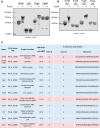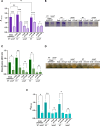Lysine polyphosphate modifications contribute to virulence factors in Pseudomonas aeruginosa
- PMID: 40243364
- PMCID: PMC12077175
- DOI: 10.1128/mbio.00855-25
Lysine polyphosphate modifications contribute to virulence factors in Pseudomonas aeruginosa
Abstract
Inorganic polyphosphate (polyP) is a universally conserved polymer involved in various biological processes, but its role as a direct protein regulator remains largely unexplored. Lysine polyphosphate modification (KPM), a strong but non-covalent interaction between polyP and lysine-rich protein sequences, has not been functionally characterized until now. In this study, we present the first investigation into KPM's biological significance using Pseudomonas aeruginosa, a critical priority pathogen known for its antibiotic resistance and virulence. We identified two essential bacterial proteins, EngA and SrmB, as novel KPM targets. Through site-specific lysine deletions, we demonstrated that disrupting lysine-polyP interactions severely impairs biofilm formation and significantly reduces the production of key virulence factors, including pyoverdine and pyocyanin. These findings establish a direct functional link between polyP and bacterial pathogenicity mediated by KPM. Our results highlight KPM as a previously unrecognized regulatory mechanism critical for controlling bacterial virulence factors. This work uncovers the first functional role of KPM and its importance in regulating virulence phenotypes in a major human pathogen.IMPORTANCEPolyphosphate is commonly known for its roles in metabolism and stress response. How inorganic polyphosphate (polyP) facilitates bacterial virulence has remained largely elusive. This study reveals that lysine polyphosphate modification (KPM), a chemical interaction between polyP and lysine-rich proteins, is essential for bacterial survival and pathogenicity in P. aeruginosa, a harmful microbe responsible for difficult-to-treat infections. We discovered that disrupting KPM in key proteins impairs the bacteria's ability to form protective biofilms and produce harmful toxins. This previously unknown biological process links polyP to protein function in controlling bacterial virulence factors. Our findings open new possibilities for developing anti-virulence therapies aimed at reducing bacterial infections without promoting antibiotic resistance.
Keywords: EngA and SrmB; Pseudomonas aeruginosa virulence; biofilm formation; lysine polyphosphate modification; lysine-rich motif.
Conflict of interest statement
The authors declare no conflict of interest.
Figures


Similar articles
-
Pseudomonas aeruginosa kills Staphylococcus aureus in a polyphosphate-dependent manner.mSphere. 2024 Oct 29;9(10):e0068624. doi: 10.1128/msphere.00686-24. Epub 2024 Oct 4. mSphere. 2024. PMID: 39365057 Free PMC article.
-
The HigB/HigA toxin/antitoxin system of Pseudomonas aeruginosa influences the virulence factors pyochelin, pyocyanin, and biofilm formation.Microbiologyopen. 2016 Jun;5(3):499-511. doi: 10.1002/mbo3.346. Epub 2016 Mar 14. Microbiologyopen. 2016. PMID: 26987441 Free PMC article.
-
Pseudomonas aeruginosa glutathione biosynthesis genes play multiple roles in stress protection, bacterial virulence and biofilm formation.PLoS One. 2018 Oct 16;13(10):e0205815. doi: 10.1371/journal.pone.0205815. eCollection 2018. PLoS One. 2018. PMID: 30325949 Free PMC article.
-
Roles of Two-Component Systems in Pseudomonas aeruginosa Virulence.Int J Mol Sci. 2021 Nov 10;22(22):12152. doi: 10.3390/ijms222212152. Int J Mol Sci. 2021. PMID: 34830033 Free PMC article. Review.
-
The Secreted Aminopeptidase of Pseudomonas aeruginosa (PaAP).Int J Mol Sci. 2024 Aug 2;25(15):8444. doi: 10.3390/ijms25158444. Int J Mol Sci. 2024. PMID: 39126017 Free PMC article. Review.
Cited by
-
Identification of polyphosphate-binding proteins in Escherichia coli uncovers targets involved in translation control and ribosome biogenesis.mBio. 2025 Aug 13;16(8):e0050025. doi: 10.1128/mbio.00500-25. Epub 2025 Jul 7. mBio. 2025. PMID: 40621900 Free PMC article.
References
MeSH terms
Substances
Grants and funding
LinkOut - more resources
Full Text Sources

